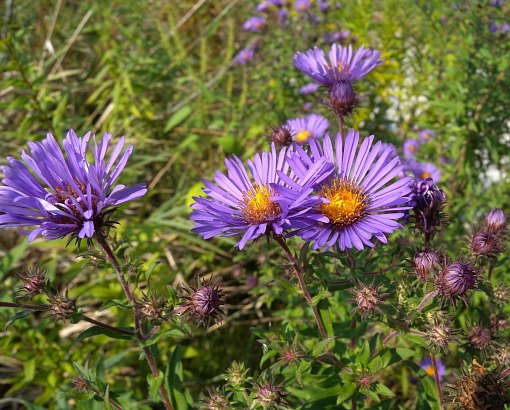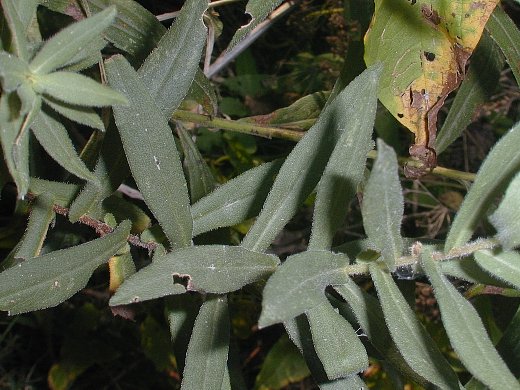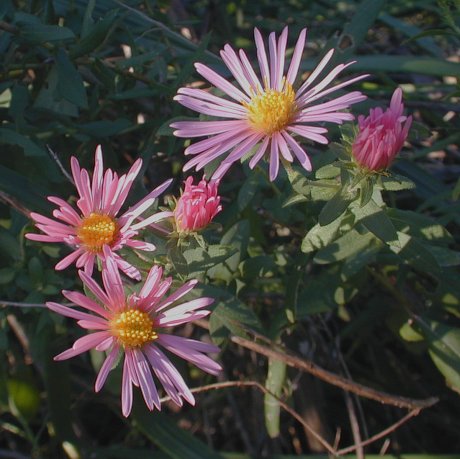Description: This herbaceous perennial plant is up to 4' tall, consisting of a central stem that branches occasionally near the top. The central stem and side branches are covered with short white hairs. The alternate leaves are up to 4" long and 1" wide, becoming smaller as they ascend the flowering stems. They are lanceolate or oblong, pubescent, and clasp the stem at the base of each leaf. Their margins are smooth, but ciliate.

Clusters of
composite flowers occur at the ends of the upper stems. Each composite
flower consists of numerous gold or yellow disk florets, which are
surrounded by 30 or more ray florets that are purple, lavender, or
light pink. Each composite flower is about 1½" across. A mature plant
may bear two dozen or more of such flowers, putting forth a showy
display. There is no noticeable floral scent. The blooming period
occurs from late summer to fall, and lasts about 2 months. The root
system consists of a stout caudex with fibrous roots, which often
produces short thick rhizomes, enabling this plant to spread
vegetatively. The achenes are longitudinally ribbed and slightly hairy,
with tufts of hair that enable them to be carried off in the wind.
Cultivation:
The preference is full or partial sun, and moist to average conditions.
The soil can contain loam or clay. This plant can become stressed out
by hot dry weather, often dropping its lower leaves in response, while
the remaining leaves may turn yellow or brown. Another problem is that
the stems often flop over in the absence of supportive vegetation.
Powdery mildew often afflicts the leaves during the cool, moist weather
of the fall. This is an easy plant to grow in moist conditions, but it
is more difficult to maintain in good condition throughout the year.
Sometimes it becomes aggressive and spreads vegetatively.

Range &
Habitat:
The native New England Aster occurs throughout Illinois, except in a
few southern
counties (see Distribution
Map). It is a common plant. Habitats include moist to mesic
black soil prairies, clay prairies, thickets, moist meadows in
woodlands, open areas along rivers and lakes, fens, abandoned fields,
open areas along railroads and roadsides, and miscellaneous waste
areas. Some populations are probably escapes from cultivated plants.
This plant colonizes disturbed areas readily, but it also occurs in
high quality habitats.
Faunal Associations:
The flowers are visited primarily by long-tongued bees, bee flies,
butterflies, and skippers. Short-tongued bees and Syrphid flies also
visit the flowers, but they collect pollen primarily and are
non-pollinating. Among the long-tongued bees, are such visitors as
bumblebees, honeybees, Miner bees, and large Leaf-Cutting bees.
Cross-pollination by these insects is essential, otherwise the seeds
will be infertile. The larvae of many moths feed on various parts
of this and other asters (see Moth Table). Other
insects feeding on this plant include Lygus lineolaris
(Tarnished Plant Bug), Poccilocapsus lineatus
(Four-Lined Plant Bug), Corythuche marmorata
(Chrysanthemum Lace Bug), and Macrosiphum euphoriaca
(Potato Aphid). The seeds and leaves of this plant are eatened to a
limited extent by the Wild Turkey, while deer, livestock, and rabbits
occasionally browse on the foliage, sometimes eating the entire plant.
However, New England Aster isn't a preferred food source for these
animals.

Photographic
Location:
The photographs were taken at Judge Webber Park in Urbana, Illinois.
Comments:
New England Aster can be variable in terms of its size, color of the
flowers, and other characteristics. This plant has attractive flowers
with a long blooming period, but it often appears messy by the fall as
a result of drought, insects, and disease. It is easy to distinguish
this aster from other asters (Symphyotrichum
spp.), because its compound flowers are larger in size
and they have more numerous ray florets.